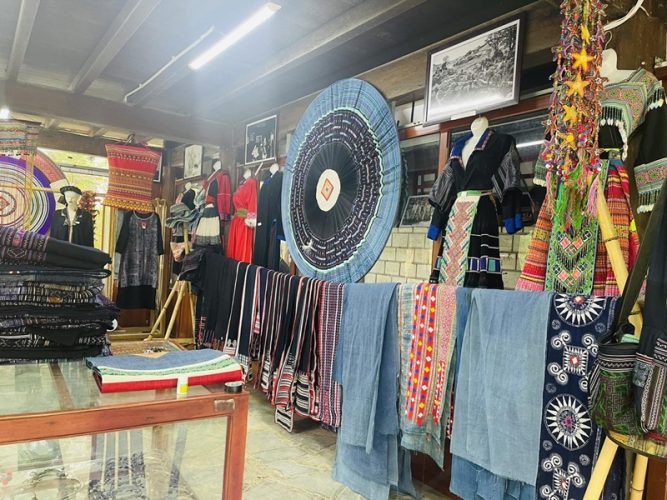Sapa Culture Museum: What you need to know before you go
Mentioning Sapa evokes images of cool weather, misty landscapes, and the ancient stone church that has stood for generations. Yet, nestled within this serene setting lies a gem of cultural significance: the Sapa Culture Museum. For visitors, it’s a portal to the rich tapestry of history and traditions woven by the indigenous ethnic groups. Situated in the heart of Sapa town, this museum is not just a repository of artifacts; it’s a window into the soul of the Northwest region. Let’s embark on a journey to uncover the captivating allure of Sapa’s cultural heritage at the Sapa Culture Museum!

Sapa Culture Museum Overview:
- Address: 02 Fansipan Street, SaPa Town, Lao Cai Province, Vietnam
- Opening Hours: The museum welcomes visitors every morning from 7:30 a.m. to 11:30 a.m., and in the afternoon from 1:30 p.m. to 5:00 p.m.
- Ticket Price: Admission to the Sapa Culture Museum is free of charge.
Situated in the picturesque town of Sapa in northern Vietnam, the Sapa Culture Museum stands as a testament to the rich cultural heritage of the region’s ethnic minority groups. Established in 2007, this museum serves as a repository for artifacts. It exhibits showcasing the daily lives, traditions, and history of the various ethnic communities residing in Lao Cai province and the broader Northwest region.
Housed within a quaint two-story wooden building on Fansipan Street, the museum offers visitors a comprehensive overview of the diverse cultural landscape of Sapa. With around 200 specimens on display, including traditional costumes, ancient artifacts, and interactive exhibits, the museum provides a captivating glimpse into the lifestyles, rituals, and customs of ethnic groups such as the H’Mong, Red Dao, Tay, Giay, Ha Nhi, and Xa Pho.
What to see in the Sapa Museum?
The rich cultural fabric of the area’s ethnic minority groups is revealed to visitors at the Sapa Culture Museum through an enthralling array of exhibitions and relics. Here’s a taste of what this cultural treasure trove has in store for you:
- Traditional Costumes: The museum’s collection of vibrant traditional costumes from ethnic groups such the H’Mong, Red Dao, Tay, and Giay is one of its main attractions. These exquisitely crafted clothes present each community’s distinct designs and handicrafts while providing a visual feast.

- See intricate models and replicas depicting moments from the everyday life of the ethnic minorities in the area under the heading of “Cultural Replicas.” These displays, which range from looms showing off ancient weaving techniques to life-like family get-togethers around the fire, provide an insight into the customs and cultural practices that have influenced Sapa life for many years.

- Ethnic Ceremonies: See exhibits showcasing customary wedding attire and mementos connected to ceremonies like the Red Dao community’s “Cấp Sắc” – Sac ceremonial, to learn about the cultural significance of marriage and rituals. These displays offer insightful perspectives into the rituals and traditions that ethnic minority in Sapa still hold dear.
- Models of architecture: Admire scale replicas of the soil and stilt buildings used by ethnic groups such as the H’Mong, Tay, and Ha Nhi. These painstakingly constructed models provide an insight into the region’s architectural history and the distinctive home designs of its residents.
- Historical relics: Explore Sapa’s past through meticulously conserved relics that showcase the region’s illustrious history. These displays, which include anything from religious relics and agricultural tools to ancient tools and agricultural implements, offer a glimpse into Sapa’s historical development.
- Interactive Displays: Get further insight into the customs and cultural practices of Sapa’s ethnic minority by interacting with interactive displays and multimedia presentations. These interactive features, which range from hands-on activities to video presentations, improve the tourist experience and provide a deeper understanding of the region’s cultural legacy.
How to get there
Getting to the Sapa Culture Museum is relatively straightforward, allowing visitors to access this cultural gem easily. Here’s how you can reach the museum:
- Location: The Sapa Culture Museum is conveniently situated in the heart of Sapa town, within the premises of the Lao Cai Province Tourism Promotion and Information Center. The address is 02 Fansipan Street, SaPa Town, Lao Cai Province, Vietnam.
- Transportation Options:
- Walking: If you’re already in Sapa town, the museum is within walking distance from most accommodations and attractions. Simply navigate to Fansipan Street, and you’ll find the museum at the Tourism Promotion and Information Center.
- Bicycle: Another eco-friendly option is renting a bicycle from a rental shop in Sapa town. Cycling to the museum allows you to enjoy the scenic surroundings while also getting some exercise.
- Motorbike: For those seeking greater mobility and convenience, renting a motorbike is a popular choice. Many rental shops in Sapa offer motorbike rentals at affordable rates, allowing you to explore the town and its attractions at your own pace.
- Taxi/Grab: Taxi and ride-hailing services like Grab are also available in Sapa town. You can simply hail a taxi or use the Grab app to book a ride directly to the museum.
When planning your trip to Sapa, don’t overlook the Sapa Culture Museum. It’s not only an ideal spot for capturing memorable photos but also a gateway to understanding the rich cultural tapestry of the Northwest region. Make sure to include a visit to this captivating museum in your itinerary for an unforgettable exploration of Sapa’s heritage.
Relate blog
Relate blog

Quan Lan Island in Quang Ninh Province is a magnet for travelers seeking beautiful beaches, serene surroundings, and crystal-clear waters….

Nguyen Hue walking street in Ho Chi Minh City is a vibrant hub that beckons both tourists and locals. As…

The five elements-inspired Non Nuoc Mountains, also known as Marble Mountains, consist of six limestone peaks covering an area of…

